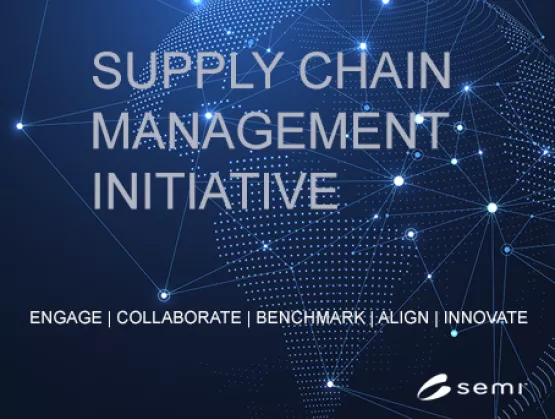
When your supply chain is in a state of equilibrium, you may ask yourself, “Why are resiliency and agility important?” The answer lies in the fact that we live in an ever-changing world with uncontrollable disruptions continuously pushing and pulling on supply chains. That’s why global electronics companies now realize and are prioritizing the value of establishing a resilient and agile supply chain to protect revenue and gain a competitive edge.
To strengthen continuity across the entire value chain and support semiconductor industry growth, SEMI launched the Supply Chain Management Initiative in early 2023 and has established an Industry Advisory Council that includes industry leaders and strategic partners such as Genpact and Resilinc. This global collaboration aims to help SEMI member companies develop an exclusive set of supply chain management standards and strategies and to educate semiconductor organizations on how to incorporate supply chain resiliency and agility best practices into their supply chain risk management (SCRM) plans.
Why is supply chain resiliency important?
Historically, sourcing and procurement have been back-office functions with one objective: to move products from point A to point B on time at the lowest possible cost. However, in today’s rapidly changing and interconnected environment, it is no longer adequate to only focus on a shipment and cost strategy. The strongest and most resilient companies in the world are those that not only survive disruptions but have the competitive advantage to win market share and improve financial performance in difficult times. The chasm between companies that make resilience and agility a corporate priority and those that do not was widened by the pandemic and the chip shortage. Companies that invested in supply chain resiliency not only survived these black swan events but thrived by creating competitive advantages.
Toyota and Apple: A step ahead
 Take Toyota, for example. During the semiconductor crisis of 2021, Toyota’s manufacturing lines first went down almost eight months after other automotive companies had already reported billions of dollars in lost profits. Toyota credited its adaptability to its supply chain risk and resiliency program, the result of years the automaker invested in mapping its supply chain and surgically protecting inventory for components with the highest impact on production. Toyota’s close ties with suppliers, characterized by transparency and collaboration, was also vital. Ultimately, Toyota withstood the chip shortages and grew its revenue, taking the crown as the largest automotive manufacturer in the world by 2021.
Take Toyota, for example. During the semiconductor crisis of 2021, Toyota’s manufacturing lines first went down almost eight months after other automotive companies had already reported billions of dollars in lost profits. Toyota credited its adaptability to its supply chain risk and resiliency program, the result of years the automaker invested in mapping its supply chain and surgically protecting inventory for components with the highest impact on production. Toyota’s close ties with suppliers, characterized by transparency and collaboration, was also vital. Ultimately, Toyota withstood the chip shortages and grew its revenue, taking the crown as the largest automotive manufacturer in the world by 2021.
 Apple is another good example. Long before the chip shortage, the company established a strategic inventory management discipline and stockpiled critical components, all while maintaining strong partner relationships. When the shortage hit, Apple leveraged its contingency inventory procurement strategy to generate record-breaking profits even as the competition struggled to clear bottlenecks in their own supply chains.
Apple is another good example. Long before the chip shortage, the company established a strategic inventory management discipline and stockpiled critical components, all while maintaining strong partner relationships. When the shortage hit, Apple leveraged its contingency inventory procurement strategy to generate record-breaking profits even as the competition struggled to clear bottlenecks in their own supply chains.
Aligning the semiconductor industry on supply chain resiliency and driving action
Under the guidance of the SCM Industry Advisory Council, SEMI has launched two Working Groups to develop standardized tools, processes and methodologies to sharpen the industry’s focus on supply chain resiliency and agility.
The Resiliency Working Group is in the process of defining and implementing a standardized process for multi-tier risk mapping, a framework for risk management, and resiliency metrics to help companies better manage unexpected supply chain disruptions. Some of the key recommendations from Working Group members include unveiling the secrets that lie beyond your tier 1 supply base by mapping your sub-tier suppliers, otherwise known as multi-tier mapping, and implementing AI-powered event and disruption monitoring. A key principle of a resiliency strategy is knowing your supply chain down through the sub-tiers, identifying risk points, and prioritizing mitigations based on disruption impact.
The Agility Working Group is defining and developing leading and lagging Supply Chain Management indicators and dashboards to help accelerate decision-making when supply chain disruptions erupt. This framework focuses on rapidly reporting unexpected changes while maintaining consistent customer service levels, service level agreements, liquidity, and cost structures. A key factor in creating agile supply chains is strong relationships with partners throughout the supply chain.

Businesses cannot achieve an agile supply chain alone. Effective and transparent collaboration with partners allows companies to share information and respond quickly when disruptions occur. Rather than blindly planning, agile supply chains rely on up-to-date data to ensure adequate demand for products before manufacturing goods.
The focus for the Agility Working Group centers on a common set of metrics and dashboards by which to measure the ability of a supply chain to react to forces beyond its control. These metrics include things like the bullwhip effect, supplier resiliency scoring, and inventory buffering levels across the semiconductor segment.
If you’re interested in joining these working groups, please contact us at scm@semi.org.
Behind the scenes
Before companies begin to develop resiliency and agility project plans, they must gain a deep understanding of the processes that support best-in-class resiliency practices such as monitoring, sub-tier visibility, and resiliency scoring. Early on, prior to mapping sub-tier suppliers, for example, a company would first establish criteria that differentiate critical from non-critical suppliers in order to identify those considered essential to their supply chain.
One approach is to identify components in your products’ bill of materials that are common across a high percentage of your revenue-generating products. You would then map those common components back to your Tier 1 suppliers and list those as critical to revenue continuity. Each company would identify characteristics of critical components or suppliers in its supply chain since simply mapping every supplier spanning four or five tiers in a BOM is not initially scalable.
The organizational structure of a company’s supply chain management team is also an important consideration. Many of the highest performing teams feature a functional leader supported by a small team tasked with maintaining and maturing the company’s resiliency and agility programs over time.

About the SEMI Supply Chain Management Initiative
The SEMI Supply Chain Management initiative is the semiconductor industry’s only global platform that brings together top industry leaders to advance a more resilient and agile electronics supply chain. The initiative’s Industry Advisory Council is committed to driving engagement among players across the supply chain, facilitating data collection and ensuring alignment in global end-to-end supply chain continuity, visibility, and transparency. Through educational forums, benchmarking, standards development, and strategic partnerships, SEMI is empowering members to anticipate and mount effective responses to supply chain disruptions. To learn more, visit the SEMI Supply Chain Management webpage or contact us at scm@semi.org.
About the Author
 Chris Benham is a veteran supply chain practitioner with over 20 years of experience in the telecommunications industry, the airline sector, and the digital storage space. Throughout his career, he’s held various leadership positions focused on data and advanced analytics, commodity cost management, digital transformation, and change management. In his most recent role at Seagate Technology, Chris served as chief of staff for the chief supply chain officer, overseeing strategic direction, supply chain roadmap, board-level communications, and KPIs.
Chris Benham is a veteran supply chain practitioner with over 20 years of experience in the telecommunications industry, the airline sector, and the digital storage space. Throughout his career, he’s held various leadership positions focused on data and advanced analytics, commodity cost management, digital transformation, and change management. In his most recent role at Seagate Technology, Chris served as chief of staff for the chief supply chain officer, overseeing strategic direction, supply chain roadmap, board-level communications, and KPIs.